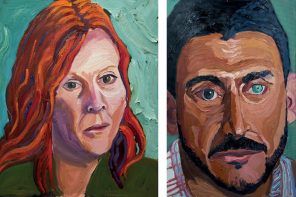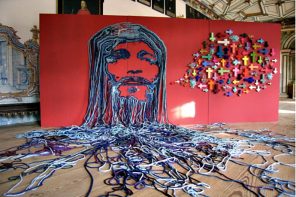The afternoon of the third day of the conference on Critical Theory that I attended in Rome (discussed in my previous post) was devoted primarily to the work of Walter Benjamin.
In the so-called Frankfurt School but not of it, Benjamin had an unusual and complex relationship to the other critical theorists I mentioned there. Several of the most prominent figures in the movement between the wars, most notably Theodor Adorno, were great admirers of Benjamin’s quirky brilliance, and sometime-boosters of his work. But the fact that he continued to write about religious topics, especially Jewish topics, was perplexing to thinkers who were committed to the critical work of Marx and Freud, among others.
Benjamin made almost mystical claims for the revelatory status of the interlinear Bible, wrote difficult and suggestive essays contrasting “divine violence” with “mystic violence,” and in some intriguing notes for a philosophy of history he never completed, he meditated on the contemporary meaning of “messianic” hope. His ideas were heterodox to be sure, but heterodoxy remains within the religious family or the tribe, as Benjamin himself seemed willing to do.
One of the most striking differences about Walter Benjamin is that he tragically failed to escape the reach of the Nazis in France, and failed to flee to the New World as most of his fellow-travelers did.
Benjamin was stopped with a group of fellow escapees at the Franco-Spanish border in 1940 and held overnight. Panicked, he committed suicide that same evening, whereas the rest of his group was ironically allowed to pass over the next day.
Clearly, Benjamin too was consumed with the core issues “Hamlet” raises, especially the spectral power of ghosts, and the tempting Modern gesture of suicide.
Arguably the most famous single essay Benjamin ever wrote is “The Work of Art in an Age of Mechanical Reproduction,” written in the charged European atmosphere of 1935 and 1936. Communists and fascists were both on the march; the civil war raged in Spain. And in this age of singular political turmoil, Benjamin elected to write primarily about Art.
“Hamlet” was a play uniquely suited to such a time, as debates swirled over whether the play should be read as a political response to several recent murders under Elizabeth, or more as a religious intervention in the theological debates between Protestants and Catholics in England. Given the fact that the play begins with a display of Hamlet the Father, Hamlet the Son, and Hamlet the Ghost, the religious dimension of the play seems fairly self-evident.
But more to the point, “Hamlet” was a play designed for live performance. What, Benjamin wonders, happens when our theater moves off the stage and is reproduced for mass distribution on celluloid? What happens when all Art can be mass reproduced and mass distributed in this way? And how are such technologies of mass reproduction related to the other political mass movements of our time?
These questions became the ghosts that haunted Benjamin’s mature thought prior to his suicide. And lying behind his interest in moving pictures is the technological innovation that started it all: photography. The early 19th century witnessed the creation of a new possibility: the mass reproduction of all the greatest art-works from around the world. The most casual student of Art History today can purchase one or several books and come to own personal copies of most of the great artistic masterworks. But what happens to the way we look at Art, when our access to it is provided primarily in this way?
What happens to the art-work itself in such an age, among such an audience? In short, Benjamin concluded, Art loses the three things that made it Art in the first place. Call them “the three A’s of Art History”: Authenticity, Authority and Aura.
A Greek statue of a pagan deity possessed an unmistakably religious aura; even the Jewish Benjamin acknowledges this. But remove that statue from its religious context, then place it in a museum, then photograph it for a booklet on “Greek art,” and the statue’s aura is lost.
What takes the place of Art’s fundamental aura? Benjamin wonders. Here his answer is brilliant, and it is a stunning supplement to Marx’s critical engagement with the Modern age and the specters of Modern capitalism. There is more to the Modern age than surplus value and exchange value, Benjamin suggests.
In the Modern age of mechanical reproduction, Art comes to have what he calls “exhibition value,” and this replaces its former “cult value.”
It is a rich idea with much to commend itself to us. At some point in the 19th century, and arguably for the first time, artists began producing art-works intended solely to be placed in a gallery or a museum. Art in the Modern age becomes a matter of exhibition, and of public display.
Perhaps no one took that insight further in the analysis of photography than the late Susan Sontag. In her groundbreaking book, On Photography, as well as a follow up project entitled Regarding the Pain of Others, Sontag performed some of the most elaborate and in-depth analyses of these subtle relations between death and display. Her thought is crystallized nicely in several theses on photography published posthumously in a volume entitled At the Same Time.
Photography, Sontag worries, was an art-form born of the desire to exhibit death, that is, to put the dead body on public display. This is one of the things that makes Matthew Brady’s famous Civil War battlefield photographs so memorable. It is a curious irony of the new medium that, in the beginning, when exposure times were so long and required still subjects, the corpse was far more easily photographed than any living being.
So the “exhibition value” of the corpse was assured. That great cultural and aesthetic transformation has not come to rest in our time, where the corpse is arguably one of the regular images featured in newspapers and the nightly news.
Benjamin put this same point as pithily, though in a slightly different way. When we watch a play, he suggested, we identify with a character. When watching a movie, we identify with the camera.
Here is the great irony for a critical Modern reading of “Hamlet.” Shakespeare’s audience at the Globe Theater could still identify with the melancholic Prince. Watching a film adaptation of that great play, we can only identify with the images the camera provides for us. We can only see the play passively, from a single visual angle. And if the camera is focused on Laurence Olivier, well then so are we.
Naturally, and by extension, the live audience at the Eucharist is invited to identify with Christ in a way that Mel Gibson’s The Passion cannot replicate, despite American audiences’ apparently impassioned reactions. What was really going on at such screenings had more to do with what worried Benjamin and Sontag so: the Modern fascination with the visual exhibition of torture. There is a fine line linking that film to the photographs taken at Abu Graib…
In short, the camera is not best suited to the presentation of Hamlet’s great soliloquies. “Such stuff as dreams are made of” do not have exhibition value, and neither do ghosts. But corpses do. So the images that stick best to the celluloid are Ophelia’s corpse floating on water, or Hamlet’s corpse, dominating the stage in death. And that is why they stick best to the Modern memory as well.
Ironically, what is missing is what started it all: Hamlet’s earnest conversation with a ghost.




